Gloucester Corporation Light Railways
(Gloucester Corporation Tramways)
History
In late 1899, the operators of Gloucester's horse tramway — the City of Gloucester Tramways Company — applied for a Light Railway Order to extend its small system outside the city boundary, and to use electric traction. For some reason, the company did not see fit to consult the city corporation ahead of this move, a step that would ordinarily have earned a tramway company the undying enmity of a local authority. Luckily for the company, this did not happen in Gloucester, possibly because it was willing to sell the tramway to the corporation, or alternatively, to operate it itself, with electricity being profitably supplied by the corporation.
Unfortunately, an agreement on a price, either for electricity or for the tramway, could not be reached, so the LRO was effectively stalled for the best part of two years. Negotiations recommenced at the end of 1901, the company being in a relatively strong bargaining position, as the corporation did not have the power to compulsorily purchase the tramway until 1911. A price was eventually agreed, the corporation taking formal ownership on the 30th September 1902, but with the company agreeing to continue operation until the corporation could take over itself, which took place on the 1st January 1903.
The corporation now pushed forward its own plans to expand the system and to convert it to electric traction; unfortunately, the corporation's draft Light Railway Order now ran into opposition from Gloucester County Council, which did not want the corporation building a tramway in its area (i.e., the planned line out from the city boundary to Hucclecote and Brockworth). Agreement between the two authorities was, however, eventually reached, powers to construct 7.1 miles of electric tramway being granted on the 7th August 1903, under the Gloucester Corporation Light Railways Order, 1903. On the same day, Gloucester County Council acquired powers to construct their portion of the system (3.6 miles) — under the County of Gloucester (Gloucester and Brockworth) Light Railways Order, 1903 — the operation of which would (by prior agreement) be leased to Gloucester Corporation.
Construction of the new electric tramway, which was to a narrower gauge than the horse tramway (3ft 6ins as opposed to 4ft 0ins), commenced on the 9th November 1903. As reconstruction progressed, the horse-tram services were gradually cut back, the last horse tram of all running on the 17th March 1904.
The first electric services commenced running on the 29th April 1904 over the newly reconstructed Bristol Road to Hucclecote line, and the Stroud Road line. Although the system was quickly completed by the opening of the Cemetery Road and Park End Road lines, it did not include the projected line beyond Hucclecote to Brockworth, which the corporation and the county council decided not to proceed with.
The 3ft 6ins-gauge overhead electric system was centred on the Cross, lines running: southwestwards along Southgate Street to its junction with Stroud Road, where the lines split, one set continuing southwestwards along Bristol Road to a terminus at Tuffley Street, the other heading southeastwards along Stroud Road to a terminus near Reservoir Road in Tuffley; northwestwards along Westgate Street to Westgate Bridge; northeastwards along Northgate Street to its junction with Worcester Street, where the lines split, one set running along Worcester Street to a terminus in Kingsholm, just beyond Denmark Road, and the other set continuing northeastwards along London Road, before turning southeastwards along Barnwood Road to a terminus at Churchdown Lane in Hucclecote; and southeastwards along Barton Street to a terminus at Cemetery Road. Additionally, a line along Park End Road linked the Cemetery Road and Stroud Road lines.
As constructed, the system was just over 9 miles long and was operated for its entire lifetime by 30 electric trams, all of which were purchased in 1904.
A parcels service was introduced in early 1905, which lasted until the Great War when reduced volumes led to its withdrawal.
It soon became clear to the council that the city was simply not large enough to justify the expense it had gone to in building an electric tramway system. Only the Bristol Road to Hucclecote line could be described as profitable, the system as a whole making a mere £245 in its first working year, and that only being achieved as the corporation did not need to start paying the construction loan back until 18 months has passed. As soon repayments came due, the corporation had no other choice but to place a levy on the rates, which by 1907 was £4,863, a hefty 14% of the overall municipal rates. Although cut backs were implemented, including an abortive attempt to withdraw services on the Westgate line, the losses were set to continue.
The tramways department did everything it could to make the system pay, introducing inducements to motormen to reduce electricity consumption which proved to be very successful, the GCLR having the lowest consumption per car mile (in 1912) in the entire country. However, no matter how efficient the services were, the simple fact was that there were simply not enough passengers, the system also having the lowest receipts in the country.
The Great War brought significant pressures to the tramway, including the loss of skilled men to the armed forces, which along with severe restrictions on the availability of materials, saw maintenance dramatically cut back. The lack of motormen eventually led to the withdrawal of services on the Westgate line — on the 11th August 1917 — though this time the corporation got its own way, and the line never reopened.
The system was, however, extended in 1917, from Hucclecote to a new aerodrome at Brockworth. The extension was authorised by the War Department under the Defence of the Realms Act, materials being taken from the defunct Westgate line to build it. The new line was used to build and service the aerodrome, public passenger services not being provided.
The early 1920s were a time of severe financial challenge, and despite operating on a shoestring, the losses continued, at one time accounting for nearly 16% of the municipal rates. Despite this, the system was briefly expanded on the 12th July 1922 with the introduction of passenger services on the Brockworth extension (to the Victoria Inn). Powers for these were granted under the County of Gloucester (Gloucester and Brockworth) Railways (Revival of Powers) Act, 1922. The services, which were only run in summer, do not appear to have been particularly remunerative, given that they ran for the last time just 27 months later on the 1st October 1924. The extension took the passenger system to its maximum extent of 9.75 miles.
Towards the end of the 1920s, with several roads in need of resurfacing, the corporation was faced with a significant outlay if it were to replace the tram tracks, so took the only sensible decision, which was to remove them and replace the trams with motor omnibuses. The corporation applied for powers to abandon the tramway lines and replace the services with omnibuses and/or trolleybuses, these being granted on the 3rd August 1928 under the Gloucester Corporation Act, 1928.
The arrival of the corporation's first new motorbuses in late summer 1929 enabled it to close the majority of the tramway system. The first lines to close were those along Park End Road and Cemetery Road (on the 7th September 1929), followed by the Kingsholm line (on the 12th September 1929) and the Stroud Road line (on the 19th September 1929). This left just the Bristol Road to Hucclecote line, the most remunerative, which the corporation seemed in no hurry to replace. It was, however, only a matter of time, the last tram of all running on the 11th January 1933.
Uniforms
Photographs of corporation horse-tram crews appear not to have survived, so it is unfortunately unclear whether or not they were provided with uniforms during the 14 months of municipal operation.
Staff working the new electric services were provided with smart uniforms: motormen wore double-breasted, lancer-style style tunics with five pairs of buttons (bearing the city's coat of arms — see link — and narrowing from top to bottom), and stand-up collars; the latter bore an employee number on the bearer's left-hand side, and system initials — 'G C L R' — on the right-hand side. Conductors on the other hand, wore single-breasted jackets with five buttons, two breast pockets (with button closures), epaulettes and stand-up collars; the latter bore the same insignia as the motormen's jacket collars. Caps were initially of the drooping-peak type; they bore script-lettering grade badges — either 'Motorman' or 'Conductor' — above which an untitled Gloucester municipal-device cap badge was worn (see below). It is unclear whether the tramway badges were brass or nickel, as buttons have survived in both materials, and they were undoubtedly used across several municipal departments. The drooping-peak caps appear to have been quickly superseded by tensioned-crown peaked caps, possibly as early as 1905; the new caps continued to carry the same badges as previously.
The style of conductors' uniforms does not appear to have altered at all during the entire lifetime of the tramway (from the first electric service in 1904 through to closure in 1933). Motorman's jackets on the other hand were at some point — and certainly by the time of the Great War — changed to a double-breasted design with five pairs of buttons, three flap pockets (two hip level and one waist level) and high, fold-over collars; the latter continued to carry the same badges as the earlier jackets.
Tramcar staff were also issued with long double-breasted greatcoats with five pairs of buttons, high fold-over collars and epaulettes; the latter were fastened at the neck end with a button, and possibly bore an employee number. The collars were left plain.
Although detailed photographs of inspectors are yet to surface, a good quality photograph of the tramway's chief inspector has survived, from which information about inspectors' uniforms can be inferred. Inspectors were probably issued with double-breasted jackets with four pairs of buttons, two waist pockets (with flap closures) and lapels; the collars probably carried the grade — 'Inspector' — in embroidered script-lettering. Although photographs of senior staff from the earliest years of the system have not survived, it is likely that the caps were of the drooping-peak type. By the late-Edwardian era, senior staff caps were of the tensioned-crown type; they bore the grade — 'Inspector' — in embroidered script lettering on a hat band.
The chief inspector wore a very similar style of jacket to inspectors, but with piped chevrons on the sleeve cuffs, as well as an embellishment just above these, which may have been a monogram of the system initials ('GCLR'), though this is for now unproven. The collars and the cap bore the grade — 'Chief Inspector' — in embroidered script lettering, the latter, on a hatband with a piped border.
In 1912, the tramway employed one chief inspector, three inspectors, thirty-four motormen, thirty-six conductors and three messenger boys; the latter were also provided with uniforms.
The GCLR — like many other tramway operators — employed women as conductresses during the Great War to replace male staff lost to the armed services. Conductresses were issued with tailored, single-breasted jackets with five buttons, two breast pockets and two hip-level pockets (all with button closures), a waist belt (secured with two buttons), lapels, and epaulettes. Headgear took the form of a cloth bonnet, which was usually pinned up at one side (in the manner of an Australian slouch hat); it is likely, though by no means certain, that the standard municipal-device badge was fixed to the upturned brim at the side. Conductresses were also issued with single-breasted topcoats with off-centre buttons and high, fold-over collars; the latter do not appear to have carried any badges.
Further reading
For more information on this system see: 'Gloucester Corporation Light Railways' by S E Webb, in the Tramway Review, Nos 112 (p236-242) and 113 (p3-24); Light Rail Transit Association (1982/3).
Images
Motormen and conductors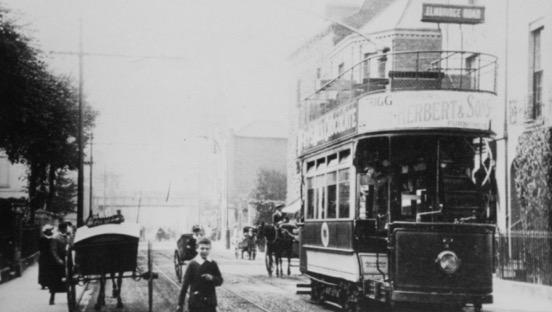
A brand-new looking Tramcar No 7 stands in Northgate Street — photo undated, but probably taken in 1904. Photo courtesy of the Tramways and Light Railway Society, with thanks to David Voice.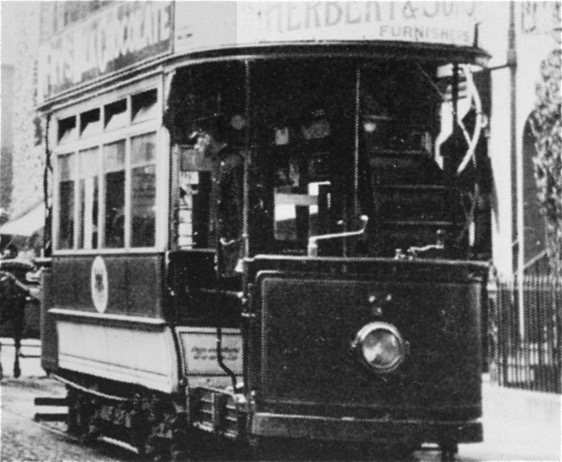
An enlargement of the above photograph showing a rather unusual side-on profile of the motorman; he is wearing a double-breasted lancer-style tunic and a drooping-peak cap.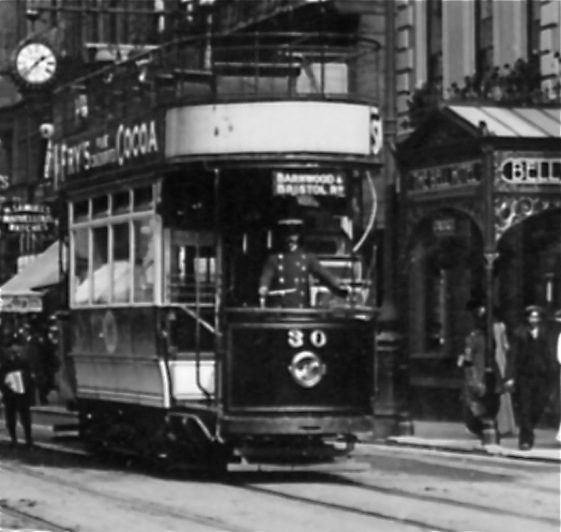
Tramcar No 30 pictured outside the Bell Hotel in Southgate Street — photo undated, but given the immaculate condition of the vehicle, probably taken in 1904/5. The motorman us wearing a double-breasted, lancer-style tunic, along with what is probably a tensioned-crown peaked cap. Photo courtesy of the Tramways and Light Railway Society, with thanks to David Voice.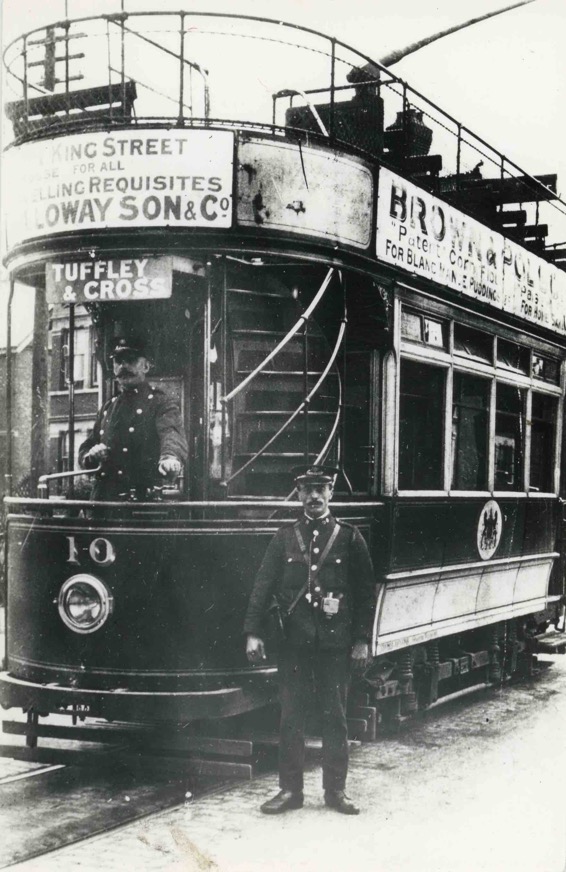
The crew of Tramcar No 10, working a service to Tuffley, pose for the cameraman — photo undated, but probably taken in the mid-to-late Edwardian era. By this time, tensioned-crown peaked caps had clearly superseded the earlier drooping-peak caps. Photo courtesy of the National Tramway Museum. 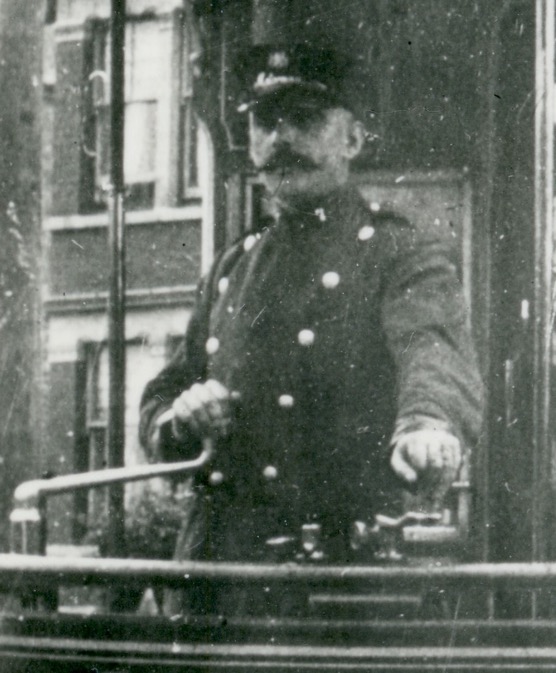
An enlargement of the above photograph showing the motorman (Employee No 7), in lancer-style tunic and tensioned-crown peaked cap, the latter bearing a municipal-device cap badge and a 'Motorman' grade badge.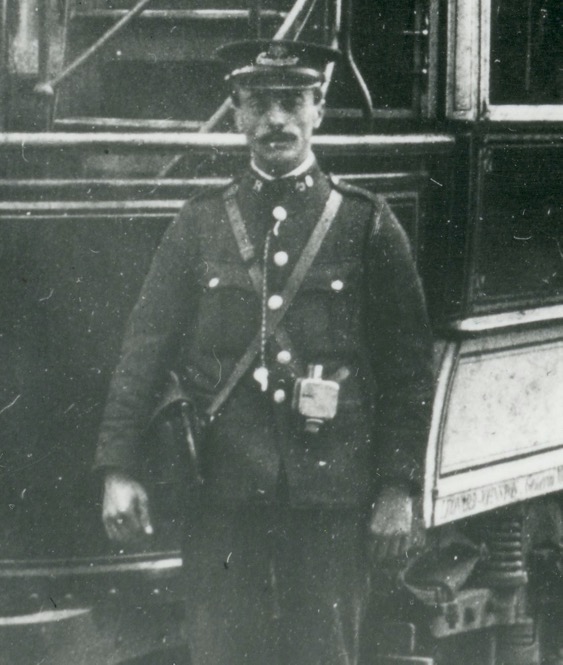
Another blow-up of the photograph of No 10 above, this time showing the conductor, who is wearing a single-breasted jacket with stand-up collars, along with a cap bearing a municipal-device cap badge and a 'Conductor' grade badge. His right-hand collar clearly bears the letter 'R', the last initial of the official system title — 'G C L R' — Gloucester Corporation Light Railways. He is possibly Employee No 30.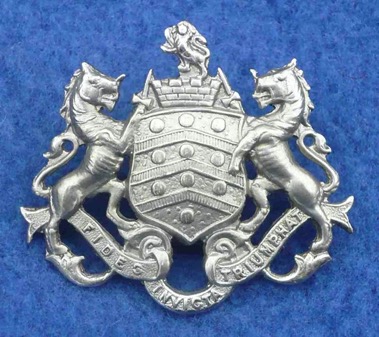
Gloucester Corporation municipal-device cap badge — nickel. Author's Collection.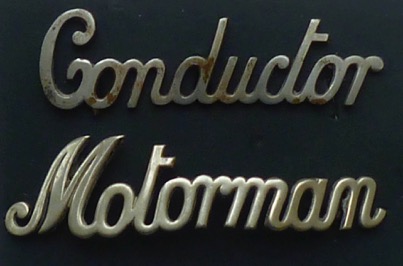
Standard off-the-shelf script-lettering grade badges of the type worn by Gloucester Corporation Light Railways staff — nickel. Author's Collection.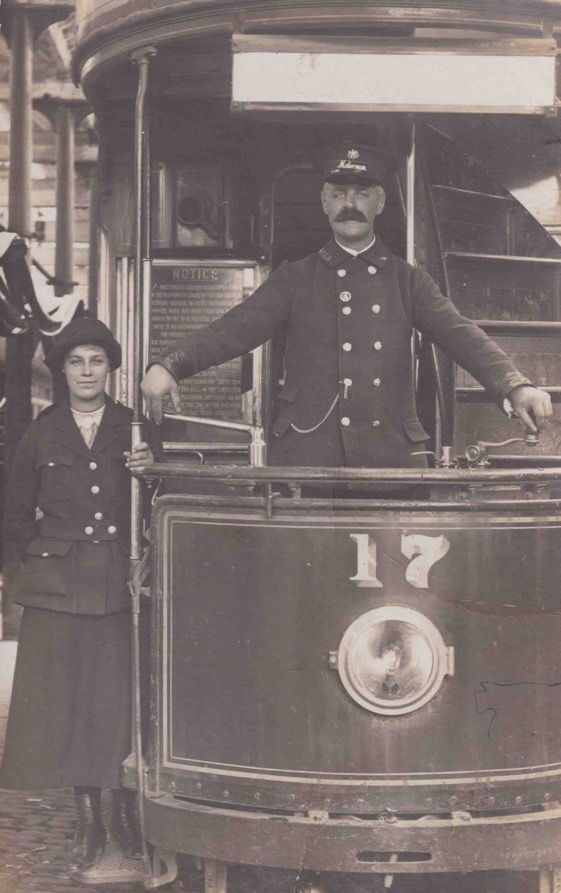
A Great War GCLR conductress and her motorman with Tramcar No 17. Author's Collection.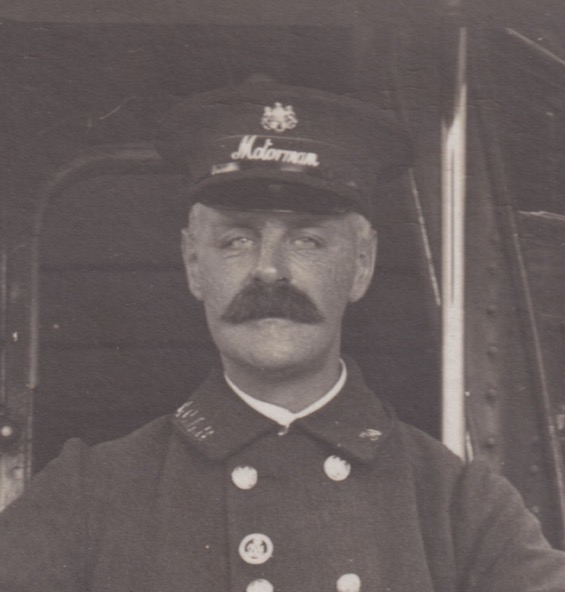
An enlargement of the above photograph showing details of the motorman's uniform insignia. The collars of his double-breasted jacket bear system initials ('G C L R') on one side, and an employee number on the other side. His is wearing a silver wound badge, indicating that he had been honourably discharged from the armed forces. 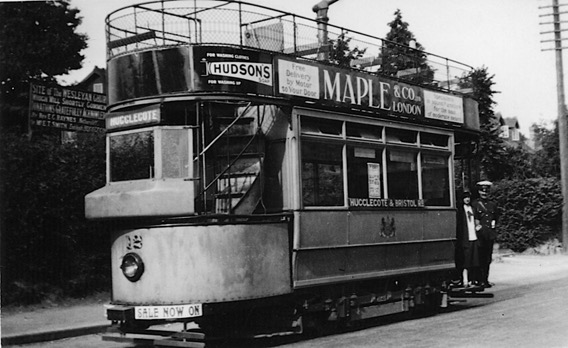
Tramcar No 12 pictured at the Hucclecote terminus, purportedly around 1929. The tramcars were painted in this rather unflattering all-over-grey livery from around 1915 onwards. Whilst many systems were forced into such exigencies by paint shortages during the Great War, most reverted to their original livery as soon as supplies permitted. Photo courtesy of the Tramways and Light Railway Society, with thanks to David Voice.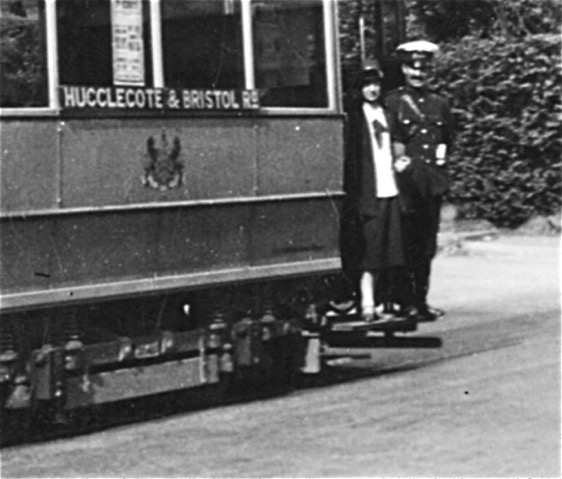
An enlargement of the above photograph, which though blurred, does show that the conductor is wearing a single-breasted jacket with breast pockets and epaulettes, suggesting that conductors' uniforms remained unchanged right through to the end of tramway operation.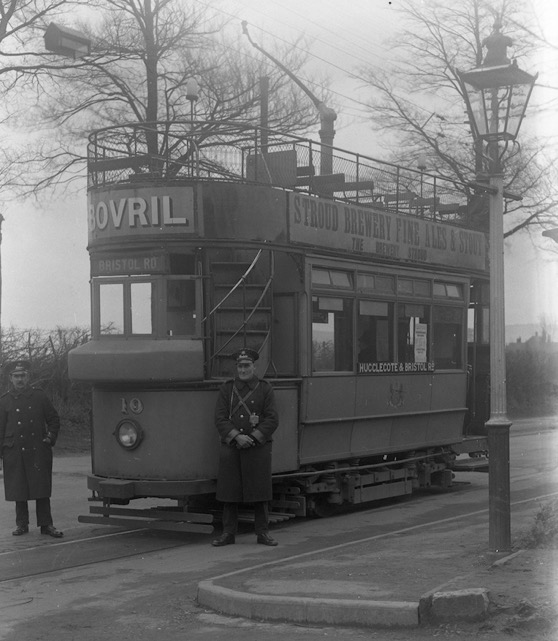
The crew of Tramcar No 10 pose for the camera of Dr H Nicol — photo undated, but probably taken in the late 1920s or early 1930s. Photo courtesy of the National Tramway Museum. 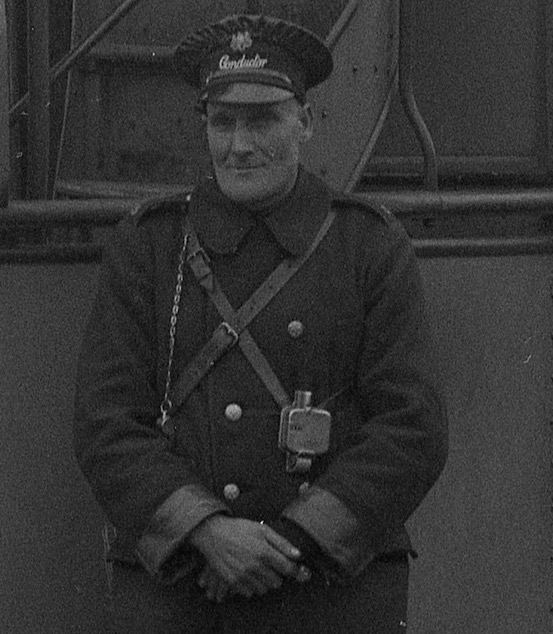
An enlargement of the above photograph, showing the conductor, whose script-lettering 'Conductor' grade and municipal-device cap badges can clearly be seen.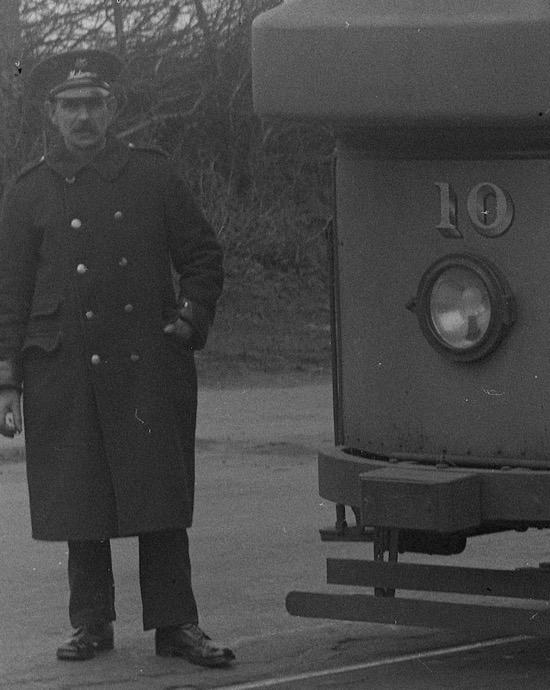
Another blow up of the photograph above, this time showing the motorman's script-lettering 'Motorman' and municipal-device cap badges.
Senior staff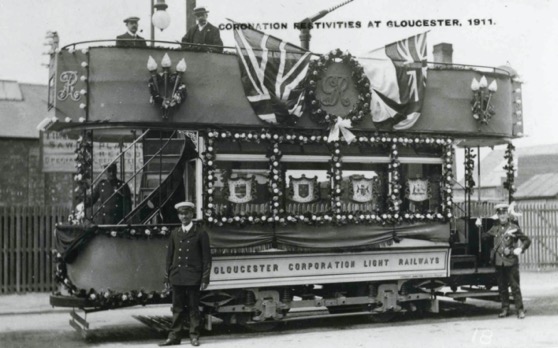
An unidentified GCLR tramcar, decorated to mark the coronation of King George V, which took place on the 22nd June 1911. The man in the foreground is the GCLR's chief inspector. Photo courtesy of the National Tramway Museum.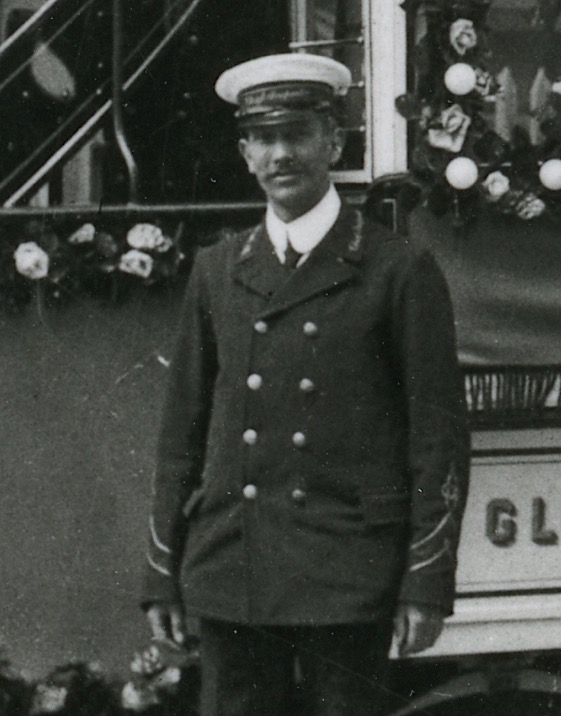
An enlargement of the above photograph showing the chief inspector. His jacket sleeve bears piped chevrons, as well as an embellishment that may comprise the system's initials. Both the cap and the collars bear his grade — 'Chief Inspector' — in embroidered script lettering.
Female staff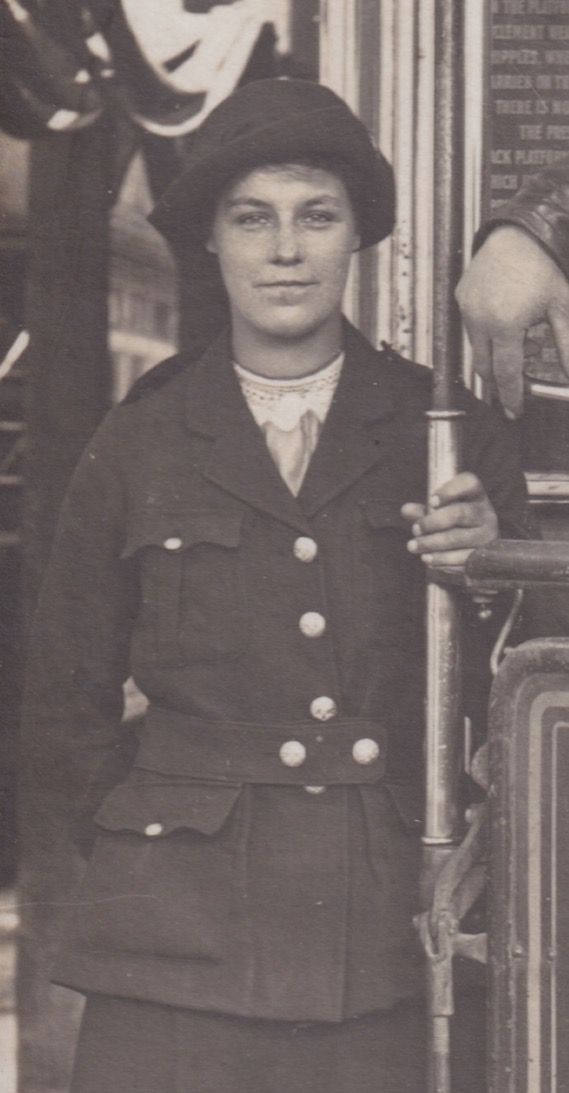
An enlargement of the Great War photograph of Tramcar No 17 above, showing the conductress. Whilst her jacket appears to be devoid of insignia, her cloth bonnet probably bears a municipal-device cap badge where it is pinned up at the side.